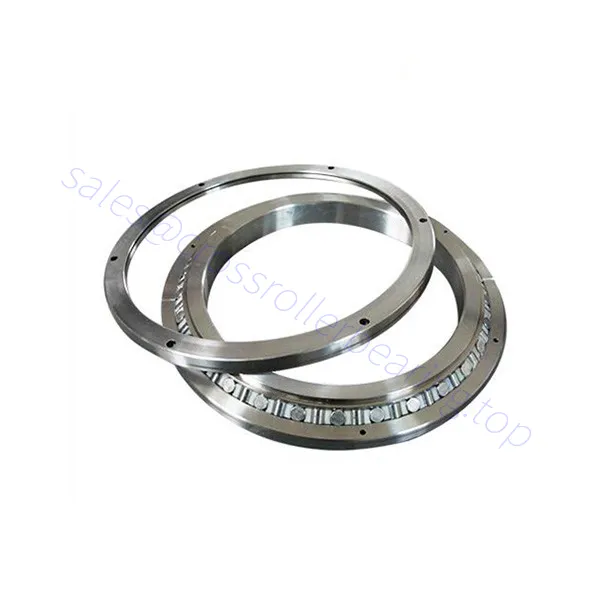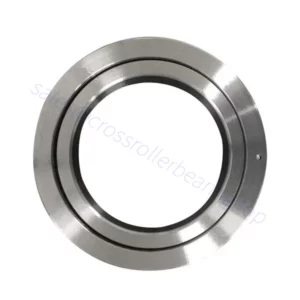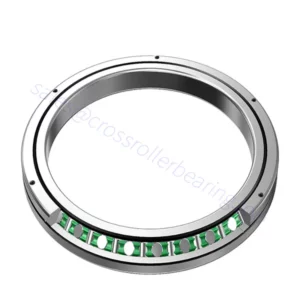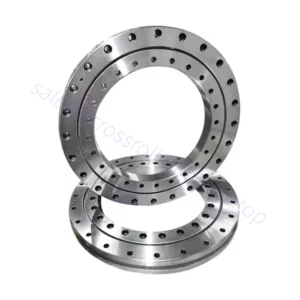Cross Roller Bearing
XR/JXR Cross Tapered Roller Bearing
The design of XR/JXR series cross tapered roller bearings can provide higher rotation accuracy and rigidity in a smaller space and significantly save material costs. This type of bearing is to install two sets of bearing raceways and rollers crosswise at right angles—the adjacent rollers face in opposite directions. A spacer is established between the rollers, which are also equipped with support shims, Which makes the two half rows of rollers fit into the same space. The included angle and tapered geometry of the bearing make the effective span of the bearing several times larger than the actual width of the bearing itself.
Mail:[email protected]
The design of XR/JXR series cross tapered roller bearings can provide higher rotation accuracy and rigidity in a smaller space and significantly save material costs. This type of bearing is to install two sets of bearing raceways and rollers crosswise at right angles—the adjacent rollers face in opposite directions. A spacer is established between the rollers, which are also equipped with support shims, Which makes the two half rows of rollers fit into the same space. The included angle and tapered geometry of the bearing make the effective span of the bearing several times larger than the actual width of the bearing itself.
Bearing Parameters
 |
 |
| Model Number | Main dimensions | Basic dynamic load rating | Limiting speed (Oil) r/m | Weight (Kg) | ||||
| Inner ring (mm) |
Outer ring D(mm) | Width B(mm) | Chamfer r(min) | Radial Cr(KN) | Axial Ca(KN) | |||
| XR496051 | 203.2 | 279.4 | 31.75 | 1.5 | 41 | 49.2 | 800 | 6.5 |
| XR678052 | 330.2 | 457.2 | 63.5 | 3 | 80 | 98.4 | 620 | 35 |
| XR766051 | 457.2 | 609.6 | 63.5 | 3 | 106 | 133 | 520 | 51 |
| XR820060 | 580 | 760 | 80 | 5 | 106 | 209 | 300 | 100 |
| XR855053 | 685.8 | 914.4 | 79.375 | 3 | 180 | 224 | 260 | 150 |
| XR882055 | 901.7 | 1117.6 | 82.55 | 3 | 225 | 297 | 200 | 185 |
| XR889058 | 1028.7 | 1327.15 | 114.3 | 3 | 283 | 374 | 160 | 400 |
| XR897051 | 1549.4 | 1828.8 | 101.6 | 3 | 326 | 489 | 80 | 500 |
| JXR637050 | 300 | 400 | 37 | 1.5 | 47.2 | 60 | 720 | 13 |
| JXR652050 | 310 | 425 | 45 | 2.5 | 61.6 | 76.5 | 640 | 20 |
| JXR699050 | 370 | 495 | 50 | 3 | 70.2 | 89.2 | 600 | 30 |
XR/JXR series cross tapered roller bearings features:
1. High precision: precision can reach P4 and P2;
2. High rigidity: all bearings of this series have preload;
3. High load capacity: can bear axial load, radial load, and overturning load
4. High speed: the rolling elements make pure rolling during the movement, so the limit speed is higher than that of crossed cylindrical roller bearings.
5. Low friction: The friction torque is much lower than crossed cylindrical roller bearings.
XR/JXR series cross tapered roller bearings application industry:
Precision rotary indexing tables for machine tools, vertical and horizontal boring machines, vertical grinders, rotary surface grinders, large gear hobbing machines, guns and radar turrets, large radio and optical telescopes, rotating cameras, microscope tables, rod center pivots, Rotating bogies, welding brackets, large tanker mooring buoys, rotary assembly fixtures, industrial robots, precision turning tables, medical equipment, measuring instruments, IC manufacturing devices, etc.
If you have the sample drawing/picture, inner and outer ring/inner and outer diameter/thickness structure of the model, matching installation size, weight, rated dynamic load, model limit speed, clearance size table, roller grain number, price/quotation, and other data If you have any questions, please call for a consultation!
Installation instructions for cross roller bearing
The cross roller bearing should be mounted with the following steps:
1. Inspection before mounting the parts:
Wash and clean the bearing base or other mounting parts to remove the dirt and confirm that the burr on the parts has been removed.
2. Mount the bearing into the bearing base or onto the shaft. Because the thin-walled bearing may be mounted tilt, it should be leveled and mounted by beating it evenly with a plastic hammer in the circumferential direction until it is fully contacted with the contact surface can be confirmed with the sound.
3. Side pressing flange mounting
(1) Place the side pressing flange in place, and shake it back and forth several times in the circumferential direction to adjust the positions of the mounting bolts.
(2) Mount the pressing bolts. Tighten the bolts manually and ensure no deviation from the bolt holes.
(3) The pressing bolts can be tightened progressively and diagonally in 3~4 stages. Slightly rotate the integrated inner or outer ring to correct the two divided parts.

Notes in use of crossed roller bearings:
The two-divided imner or outer ring fixed with special rivets or bolts and nuts inseparable. and should be diectly mounted into the bearing base for use. Meanwhile. if the spacer holder assembling sequenceis improper ,it will have a significant impact on the rotation performance of the bearing.so,the bearing can not be disassembled freely. There is some deviation athe joint of inner or outer ring, before it is mounted into the bearing seat. The bolts to fix the imner or outer ring should be loosened to correct it with a plastic hammer. (the set rivets may be deformed with the bearing base deformation)Do not apply extermal force onto the set rivets orbolts during the mounting or removal.
Please note the size tolerances of the mounting parts, and press securely the inner or outer ring with the flange from the side.
Lubrication for crossed roller bearing:
The crossed roller bearing has been filled with high-quality two # lithium grease so it can be directly mounted for use. However, compared with standard roller bearings, it has a smaller internal space. so the grease must be replenished periodically.
The grease should be replenished from the grease hole connected to the grease groove on the outer and inner rings. The grease replenishment interval is generally 6-12 months. The same grease must be replenished in all areas.
Meantime, when the grease is filled fully, the initial rotation torque will be increased quickly due to the grease resistance; when the excess grease is spilled from the seal portions, it will soon be returned to the standard torque value.






